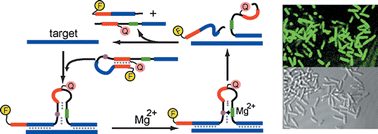Locked TASC probes for homogeneous sensing of nucleic acids and imaging of fixed E. coli cells
Abstract
We have designed a second-generation TASC (target-assisted self-cleavage) probe. It is based on the switching-on of incorporated cis-acting DNAzyme activity upon the target-induced conformational change of the otherwise inactive off-target probes locked in an intrastrand base-paired hairpin geometry. With E. coli 16S ribosomal RNA-relevant oligonucleotides as targets, the locked TASC probe exhibits an allosteric factor of kon/koff = 65 and the sequence selectivity is high, in terms of single nucleotide difference, when particular sequence and length of targets are chosen. Preliminary experiments with fixed E. coli cells show that the locked TASC probe with a FRET pair can be used to image fixed E. coli cells.


 Please wait while we load your content...
Please wait while we load your content...